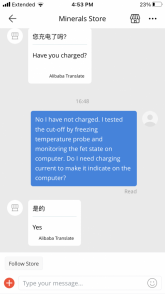CaseyB
New Member
- Joined
- Dec 7, 2020
- Messages
- 78
I just received 5 JBD-SP04S005 V1.5 BMS's with the uart to usb adapters from the vendor "Minerals" off AliExpress. They came well packaged and the shipping was from DHL. Included were the harnesses as well as 9 external NTC's (one was missing)...more about those later. I haven't ordered my LFP's yet, so I set up a "battery" with alkaline D-Cells and a Mean Well HRPG-150-3.3 power supply...
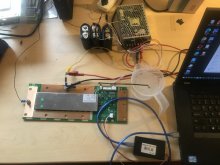
... I wired 3 sets of 2 D cells in series to stand in for LFP cells C0 thru C2, I'm using the Mean Well supply for C3. Having the supply as C3 allows me to test LV and OV cut-offs. Not seen are the 2 DVM's, one connected across the +/- terminals of the power supply and the other connected between + on the power supply and C- on the BMS. I added the 1.1k resister between C- and B+ to give a small load to the discharge fets to over come fet leakage (without the resistor it would show battery voltage on my DVM regardless of on/off state). The cup to the right of the BMS is a salt water brine left in the freezer over night for the low temp cut-off test.
I switched back and forth between the open source BMS-TOOLS , and the official JBDTools to read/write to the BMS. I much prefer BMS-TOOLS, it is way cleaner, but it doesn't have as many configuration options..I don't know if that is an issue or not.
Here is a screenshot of BMS_TOOLS configuration page...

...and here is JBDTools Configuration page...

...you can see there are more options in the JBDTools "Function Configuration" box. Back to BMS-TOOLS, here is a screenshot with everything normal...
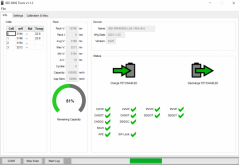
...with LV cut-off...
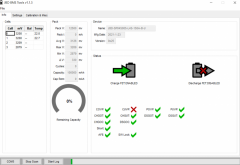
...and OV cutoff...
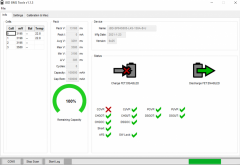
At this point I'm doing the happy dance...alas, it was not to last. Here is the low temp test...
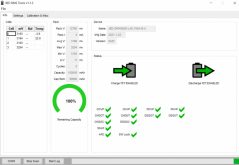
You can see the brine dropped the thermistor to -3.6C and the charge fet did not disable... no love. The other anomaly is even when I uncheck the "NTC2" box the second temp still shows, I assume the second temperature is the fet temp. I have tested all the read/write functions and they all seem to work. All 5 BMS's tested exactly the same.. I'm hoping it's as simple as not checking a box in the "Function Configuration". As all of them tested the same it seems unlikely that there is physical damage to all of them. Could it be the "RTC" box that shows up in JBDTools, but not BMS-TOOLS ? I'm a little reluctant to start clicking things on without actually knowing what they are.
The second issue is with the plug in NTC's that came with the BMS's. The BMS pins that the NTC's plug into are clearly labeled with H+ and H- on the ends...
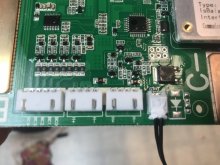
... I have read elsewhere that is switched heater power triggered by the NTC temp. The NTC connector on the left is how they were configured when I received them and the one on the right is the one I swapped pins on to match the boards. Am I correct to do this?
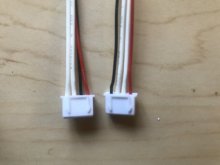
Any help the brain trust here could offer would be much appreciated.

... I wired 3 sets of 2 D cells in series to stand in for LFP cells C0 thru C2, I'm using the Mean Well supply for C3. Having the supply as C3 allows me to test LV and OV cut-offs. Not seen are the 2 DVM's, one connected across the +/- terminals of the power supply and the other connected between + on the power supply and C- on the BMS. I added the 1.1k resister between C- and B+ to give a small load to the discharge fets to over come fet leakage (without the resistor it would show battery voltage on my DVM regardless of on/off state). The cup to the right of the BMS is a salt water brine left in the freezer over night for the low temp cut-off test.
I switched back and forth between the open source BMS-TOOLS , and the official JBDTools to read/write to the BMS. I much prefer BMS-TOOLS, it is way cleaner, but it doesn't have as many configuration options..I don't know if that is an issue or not.
Here is a screenshot of BMS_TOOLS configuration page...

...and here is JBDTools Configuration page...

...you can see there are more options in the JBDTools "Function Configuration" box. Back to BMS-TOOLS, here is a screenshot with everything normal...

...with LV cut-off...

...and OV cutoff...

At this point I'm doing the happy dance...alas, it was not to last. Here is the low temp test...

You can see the brine dropped the thermistor to -3.6C and the charge fet did not disable... no love. The other anomaly is even when I uncheck the "NTC2" box the second temp still shows, I assume the second temperature is the fet temp. I have tested all the read/write functions and they all seem to work. All 5 BMS's tested exactly the same.. I'm hoping it's as simple as not checking a box in the "Function Configuration". As all of them tested the same it seems unlikely that there is physical damage to all of them. Could it be the "RTC" box that shows up in JBDTools, but not BMS-TOOLS ? I'm a little reluctant to start clicking things on without actually knowing what they are.
The second issue is with the plug in NTC's that came with the BMS's. The BMS pins that the NTC's plug into are clearly labeled with H+ and H- on the ends...

... I have read elsewhere that is switched heater power triggered by the NTC temp. The NTC connector on the left is how they were configured when I received them and the one on the right is the one I swapped pins on to match the boards. Am I correct to do this?

Any help the brain trust here could offer would be much appreciated.




